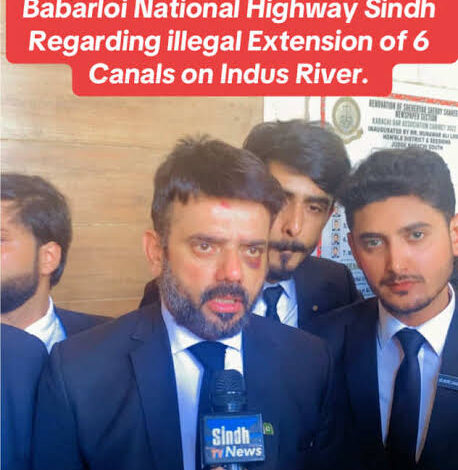Stop the Illegal Construction of Canals on the Indus River: A Call to Protect Pakistan’s Lifeline

The Indus River, frequently called the lifeblood of Pakistan, is under growing trouble due to limited mortal exertion. Among the most intimidating issues is the illegal construction of conduits along the swash’s course. These unauthorized developments not only disrupt the natural inflow of water but also pose a serious threat to husbandry, ecology, and water vacuity downstream. It’s high time to stop the illegal construction of conduits on the Indus River before the damage becomes unrecoverable.
Why the Indus River Matters
Stretching over 3,000 kilometers, the Indus River originates in the Tibetan Plateau and flows through India and Pakistan before evacuating into the Arabian Sea. It sustains the largest conterminous irrigation system in the world and supports the livelihoods of over 200 million people.The swash is essential not only for husbandry but also for drinking water, hydropower, and biodiversity. For centuries, the swash has been deified as a symbol of life and durability. Its reliable water inflow has enabled Pakistan to grow staple crops like wheat, rice, and cotton. still, this delicate balance is now being upset by mortal rapacity and governmental inactivity.
The Rise of Illegal conduit Construction
In recent times, there has been a disturbing trend the unauthorized diversion of water through immorally constructed conduits and conduits. Stop the Illegal Construction of Canals on the Indus RiverThese conduits are frequently erected by important individualities or communities without any environmental assessment, planning authorization, or governmental oversight. While these illegal conduits may serve original requirements temporarily, they inflict annihilation on the lesser ecosystem. They reduce the swash’s inflow downstream, depriving innumerous communities and ecosystems of their share of water. also, these conduct frequently go unpunished due to political influence or executive negligence. This fosters a culture of immunity, encouraging others to follow suit.
Environmental and profitable Consequences
To stop the illegal construction of conduits on the Indus River, we must first understand the ruinous consequences they bring .
1.Reduced Water Vacuity Downstream
Illegal conduits divert water that would else reach lower riparian areas, similar as Sindh and corridor of Balochistan. These regions are formerly facing acute water dearths. farther reductions in water inflow peril drinking water inventories, irrigation requirements, and the ecological balance.
2. Agrarian dislocation
Pakistan’s agrarian frugality depends on a fair and regulated distribution of water. When conduits are erected immorally, growers in downstream areas suffer due to inadequate irrigation. Crop failures lead to food instability and profitable insecurity for thousands of families.
3. Damage to washes and Wildlife
The Indus River is home to exposed species similar as the Indus swash dolphin and multitudinous migrant catcalls. dismembering the water inflow through limited conduits harms their niche and reduces biodiversity.
4. Increased threat of Flooding and Soil corrosion
inaptly erected conduits with no engineering norms increase the threat of beachfront corrosion and flooding. rather of serving the original population, they produce new environmental hazards that are expensive and delicate to manage.
Legal and Institutional inactivity
Despite clear legal fabrics like the Pakistan Environmental Protection Act, the perpetration and enforcement are weak. Original and parochial authorities frequently warrant the coffers or will to act. occasionally, they’re complicit due to political or fiscal pressures.
likewise, there’s minimum public mindfulness or advocacy on the issue. While large heads and water controversies frequently dominate captions, illegal conduits continue to grow under the radar.
results to Stop the Illegal Construction of conduits on the Indus River
To cover the integrity of the Indus River, we must take immediate and coordinated action across multiple situations .
1.Strict Legal Enforcement
Government agencies must apply environmental and water operation laws with zero forbearance for violators. Penalties should include forfeitures, obliteration of illegal conduits, and felonious execution of those responsible.
2. Remote Sensing and Monitoring
Use of satellite imagery and drone technology can help identify unauthorized constructions in real time. Authorities can also act snappily to halt illegal systems before they’re completed.
3. Community Engagement
Empowering original communities to report illegal conditioning can be a game changer. When people are made apprehensive of the long- term damage caused by illegal conduits, they’re more likely to repel and report similar conduct.
4. Transparent Water Management
Federal and parochial water authorities should maintain public records of all approved water systems. This translucency can help watchdog associations and media hold officers responsible.
5. public Dialogue and Media Coverage
Mainstream media and environmental NGOs need to amplify the urgency of the issue. Greater public pressure will push politicians and policymakers to act decisively.
Conclusion
The need to stop the illegal construction of conduits on the Indus River is n’t just an environmental concern it’s a public exigency. The unbounded diversion of water through unauthorized means threatens the veritably foundation of Pakistan’s frugality and ecology.
still, we risk losing the balance that the Indus River has maintained for glories, If we fail to act now. unborn generations will inherit a barren geography, where conflict over water becomes a norm rather than an exception.
The time to act is now. Let us cover the Indus River, not just for ourselves, but for all who depend on its waters for life and livelihood.





